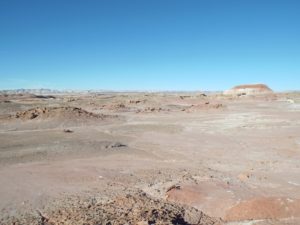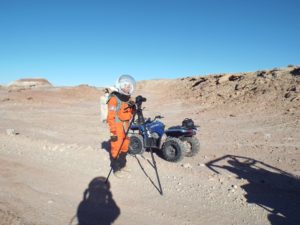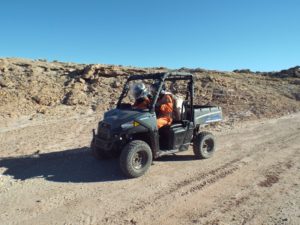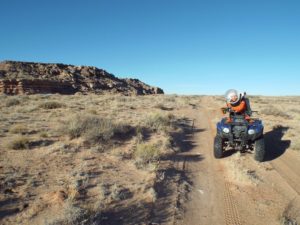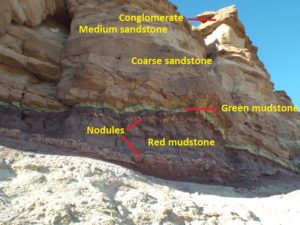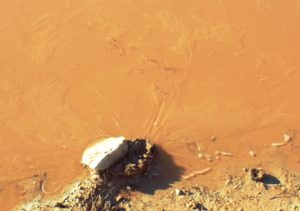EVA Narrative – December 5th
EVA NARRATIVE 5/12/16
Jon Clarke
Small sandstone breakaways
The subject of today’s narrative is an EVA along Pleiades Rd, a back track through the eastern part of the MDRS field area. Four of us set out, Anushree and Anastasiya in the Phobos electric rover, Alex and I on the quad bikes. The EVA was also aimed at testing Alex’s astronaut user interface (SUIt). First we headed north on Cow Dung Rd to check out a final outcrop for my palaeochannel work and to get some footage for Anastasiya. I was interested in a series of breakaways (small mesas) whose relation to the larger palaeochannels was ambiguous. I concluded the were associated with crevasse splays, or ruptures in the natural levees of the Jurassic river banks that resulted in deposition of sand bodies that are now preserved as the breakaway caps. Alex and Anushree then headed back to the station in Phobos, with Anushree driving for the first time, another milestone for her at MDRS!
Anastasiya filming a video segment
Alex and Anushree in Phobos
Anastasiya and I then head south along Pleiades Rd. This is a rough track, washed out in places, that runs to the east of a break in the landscape. This is formed by a low (5-10 m) discontinuous escarpment composed of a widespread conglomerate and sandstone unit that marks the break between the clay-rich Brushy Basin Member of the Morrison Formation above and the sand-rich Salt Wash member of the same formation below. The upper 5-10 m of the Salt Wash Member is less sandy than the rest of the Salt Wash Member below, and containing broad sandstone tracts and sheets, red siltstone and minor mudstone interbedded with fine sandstone. This represents the ancient floodplain deposits of the braided rivers that formed the Member, in contrast to the fixed channels and clay-rich flood plains that characterised the Brushy Basin Member.
Escarpment along Pleiades Rd
Close up, the edges of the escarpment reveal many details of the processes that occurred during the deposition of the sediments and subsequent processes that modified their composition and texture. This later medication, which turns unconsolidated sediment into rock, is called diagenesis. Understanding diagenesis is important not only from an academic perspective, but is also of crucial importance in economic geology. The sediments of the Colorado Plateau, including the Salt Wash Member, form a world-class uranium province, and a distinct category of mineralisation is named after them. They are formed by groundwater flowing through sandstones such as these and reacting with organic matter in the surrounding sediments or in the sandstones themselves. While such uranium mineralisation is extremely unlikely on Mars, other diagenesis-related mineral accumulations may not be. Understanding martian diagenesis will be as important in the exploration for martian resources as it is in exploration for terrestrial resources.
Annotated diagram showing different rock types exposed along the edge of the escarpment.
However, on our EVA, resources were far from our mind. We were more interested in the immediate issues of driving along the track. Riding a quad bike, like riding a horse, is something of a workout, as you have to steer, keep your balance, and constantly adjust your posture at the quad bike moves over the uneven terrain, all while wearing 17 kg of the simulates space suit. On the way we came across a small water reservoir, with a thin film of ice on it. Ice is something we would expect to see on Mars, but not open water, except perhaps at the lowest elevations and only briefly on the warmest days.
Ice!




